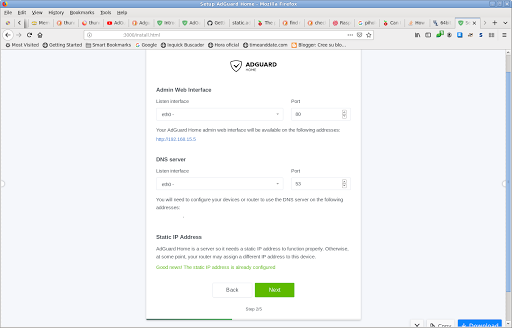
You have successfully installed AdGuard Home on your VPS or Raspberry Pi! Now you can enjoy ad-free browsing on any device connected to your network.
Create an admin account with a username and passwordĪfter completing these steps, you should see a dashboard that shows statistics about queries processed by AdGuard Home.  Select filters that will block ads and trackers from various sources. Enable encryption protocols such as DoH or DoT if you want more security and privacy. Choose an upstream DNS server that will resolve queries that are not blocked by AdGuard Home. Set a static IP address for your device if you haven’t done so already. Change the listening interface to the IP address of your device. Here are some steps that you may need to follow: You will see a welcome screen that will guide you through the initial configuration process. Once AdGuard Home is installed on your device, you can access its web interface by typing its IP address followed by port 3000 in your web browser. This will take care of everything for you. To install AdGuard Home on your device, type: curl -sSL | sh This command will download the proper version of AdGuard Home for your device architecture (armv6l for Raspberry Pi Zero/1/2/3 or armv7l for Raspberry Pi 4), install it as a service that will start automatically at boot, and launch it. To install AdGuard Home on your device, you just need to copy and paste one command line from their GitHub project page. This will update all the packages on your device. Then type: sudo apt-get -y update sudo apt-get -y upgrade (where 192.168.10.20 is the IP address of your device) To update your device, open your SSH client and connect to your device using its IP address and password. This will ensure that you have all the necessary packages and security patches. Let’s get started! Step 1: Update your deviceīefore installing AdGuard Home, it is always a good idea to update your device to the latest version of your Linux distribution. A web browser to access the AdGuard Home web interface. An SSH client to access your device remotely (I recommend PuTTY for Windows users). A VPS or Raspberry Pi with any Linux distribution installed (I recommend Raspberry Pi OS Lite for Raspberry Pi).
Select filters that will block ads and trackers from various sources. Enable encryption protocols such as DoH or DoT if you want more security and privacy. Choose an upstream DNS server that will resolve queries that are not blocked by AdGuard Home. Set a static IP address for your device if you haven’t done so already. Change the listening interface to the IP address of your device. Here are some steps that you may need to follow: You will see a welcome screen that will guide you through the initial configuration process. Once AdGuard Home is installed on your device, you can access its web interface by typing its IP address followed by port 3000 in your web browser. This will take care of everything for you. To install AdGuard Home on your device, type: curl -sSL | sh This command will download the proper version of AdGuard Home for your device architecture (armv6l for Raspberry Pi Zero/1/2/3 or armv7l for Raspberry Pi 4), install it as a service that will start automatically at boot, and launch it. To install AdGuard Home on your device, you just need to copy and paste one command line from their GitHub project page. This will update all the packages on your device. Then type: sudo apt-get -y update sudo apt-get -y upgrade (where 192.168.10.20 is the IP address of your device) To update your device, open your SSH client and connect to your device using its IP address and password. This will ensure that you have all the necessary packages and security patches. Let’s get started! Step 1: Update your deviceīefore installing AdGuard Home, it is always a good idea to update your device to the latest version of your Linux distribution. A web browser to access the AdGuard Home web interface. An SSH client to access your device remotely (I recommend PuTTY for Windows users). A VPS or Raspberry Pi with any Linux distribution installed (I recommend Raspberry Pi OS Lite for Raspberry Pi). 
In this blog post, I will show you how to install AdGuard Home on a VPS or Raspberry Pi using a simple command line. It also gives you full control over your DNS settings, allowing you to customize filters, whitelist domains, block services, and more. It can block ads, trackers, malware, phishing, and other unwanted content from your network.

AdGuard Home is a powerful ad blocker and DNS server that can run on any device, including a VPS or Raspberry Pi.







 0 kommentar(er)
0 kommentar(er)
